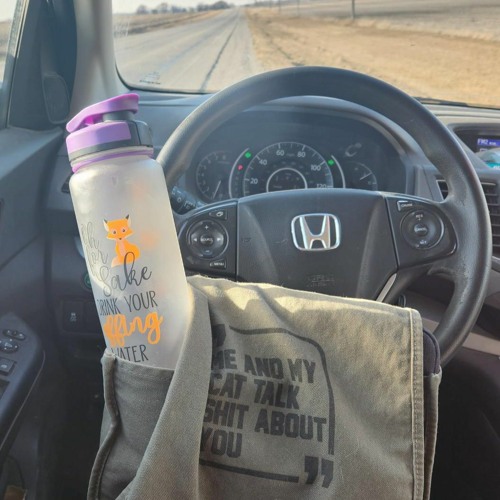With the world rapidly changing, efforts have been made to limit our carbon footprint, however, is it enough? On Climate Change Now we take a look at effects a changing climate is already having on our environment. On this episode, we look at extreme temperatures, agriculture performance, drought conditions, direct environment impacts, plus more! Tune in to Climate Change Now.
Joshua Woolcott: Soil health…
Rich Crowe: *Teaser*
Joshua Woolcott: Excessive droughts…
Abby’s Source: *Teaser*
Joshua Woolcott: Water availability…
Dr. Geoffrey Ecker: *Teaser*
Joshua Woolcott: and the health of local Iowan Wildlife.
Tom Litchfield: So, the number of deer that’s been reported so far makes this year currently the third largest outbreak documented in modern times in Iowa, and being in 73 counties, it’s the most widespread outbreak that we’ve ever documented.
[MUSIC]
Joshua Woolcott: Welcome to “Climate Change Now”, a show where we delve into Climate and its affects on our local communities, I’m Joshua Woolcott. For the past several months, Iowa, as well as many other parts of the world, have been experiencing record-breaking temperatures. Excessive high temperatures like this, over time, can eventually affect the health of the soil. Rich Crow, a BVU Professor of Agriculture, came into the studio for an interview to discuss some of the potential implications of this.
[MUSIC]
Joshua Woolcott: Would you be able to first explain how the temperature of soil can affect crops?
Rich Crowe: Crops are what I described as a cold blooded being, meaning they grow in relation to the temperature that they are experiencing from around them. And within the soil, you’ve got your root structure of the plants, and the activity of the roots are directly related to the soil temperature they’re experiencing. Typically, we use the figure of about 50 degrees, it’s kind of that magic number, when looking at soil temperatures, and especially corn and soybeans being the major crop around here, we’ll use those as examples. The roots of those crops are just like you and I, right, they experience heat and cold, and they react accordingly. And so that 50 degree temperature for corn and soybeans is kind of that magic number, below 50 degrees, they slow down, and they are very, they’re cold, right. And so the intake of water intake of nutrients, and their reactions to that is very much slowed above 50 degrees, they begin to speed up up to about 86 to 90 degrees, depending on whose information you want to use, as far as the maximum rate at which they will function.
Joshua Woolcott: So recently, over the last couple of months, it started in the summer, it’s still going now in November, we’ve experienced a lot of record breaking temperatures, and I was curious if those record breaking temperatures affect crop health at all, if it affects harvest season at all. Let’s take a look at August through October. Is that too broad? You want to narrow that down a little more?
Rich Crowe: That should work.
Joshua Woolcott: Okay.
Rich Crowe: Yeah, so you know, your corn and soybean crops you’re getting into August, you’re into that pollination and what are called seed set or seed development timeframe, that’s very critical for yields. And both of those. And so higher than normal temperatures are obviously going to push them along quicker. As far as reaching maturity, and they’re growing faster. As we get into September, they will naturally start to shut down anyway. And so the warm temperatures say late September and October generally don’t do a lot as far as impact to the crops now where it will have impacts if that soil temperature stays above that 50 degree temperature is in the soil life, from a management perspective, it’s too short of a time period really to see a huge impact. Because when we talk about soil, generally we’re talking decades to hundreds of years for a lot of these cycles to fully play out. And so, you know, if we have one year of record breaking temperatures, it’s not going to have a huge impact in swinging the soil. As compared to let’s say we have a decade of… well , now we’re gonna have to see a significant change because soil is a slow responder, it’s not a, you know, two months major impact it’s, it’s one of those that over time will gradually change to adapt. And so if these changes in temperature are long and ongoing, we will see a definite shift in our soils. As far as how they are responding. So think about the black color of the top layer of soil, that’s a lot of organic matter. That material is being broken down continually. So you have new stuff being added from dead plants. And you have parts of that constantly broken down because the growing season now is extended because of its temperature staying warm longer. Long term effects of that, water holding ability, you know, we experienced very dry summers we’ve reduced potentially reduced a little bit of how much water can be held on the soil.
[MUSIC]
[DISTRACTED DRIVING PROMO]
Joshua Woolcott: Droughts are common in Iowa. What is also common, however, is just how unpredictable Iowa weather can be. This can make farming a… “unique”… challenge. Sometimes, those challenges yield better results than one may originally think. KBVU’s Abby Kraft has the story.
[MUSIC]
Abby Kraft: Within the last few years farmers have been seeing an increase in drought conditions. Jackson Dau and his family farm operations had seen an interesting harvest season, this year. Most farmers were expecting low yields this year because of the drought.
Jackson Dau: So a yield is a calculation. It is a calculation of product that you take off of a specific area of land. That product can be grain, cotton, or actual even livestock products. We thought we were going to see decreased yields again this year for a few reasons, actually. One of them being the fact of early season rains, very early season… delayed us from getting into the field when we would like to, when we normally would. So that pushed us roughly back by a week or two decreasing the peak maturing time. Another reason was around July 1st, is actually peak maturing time for the plant. We did not have the rain at that point that we needed for full maturing growth. The only thing that saved us was the mid-August rains. They came right at the end of maturing season and that really saved the yield this year.
Abby Kraft: Despite these conditions, many farmers ended up with higher yields. They had rain at just the right times in the season to see an amazing year for crops. Roughly, 2.5 million Iowa residents are in areas of drought according to the National Integrated Drought Information System. Buena Vista and surrounding counties are only looking at abnormally dry.
Jackson Dau: It was a kind of shock to a lot of farmers that we got the rain that we did.
Abby Kraft: Iowa specifically has been seeing drought like conditions since the 2019 harvest season.
Jackson Dau: In the past years when its been dry it takes about two weeks for you to see a sprout come through this year it took anywhere from five days to maybe 7-8 days at most. Plants were already coming through. They were maturing faster.
Abby Kraft: According to the American Farm Bureau Federation, the past two years around 70% of farmers have had a reduction in harvest yields. 2019 and 2020 farmers still had residential moisture, which is when the ground holds moisture when there is no rain fall. Farmers had lower rainfall but were still able to see positive yields during those two years. 2021 and 2022, the soil didn’t have the residual moisture to sustain crops at a normal yield with the lack of rainfall. This year, the rainfall came just when it was needed to bring yields back up.
Jackson Dau: Since crops have a specific maturity rate, the early season rains helped this year; allowing seeds to mature faster which means a longer period in which ears and pods are filled out resulting in a higher yield.
Abby Kraft: Overall, this year was better than the past few years, but farmers are still working towards finding ways to keep positive yields, despite these conditions. Hopefully, we will start seeing an increase in rainfall in Iowa within the next few years.
[MUSIC]
Joshua Woolcott: Things are hopefully looking up for farmers when it comes to Iowa’s precipitation as of late. That doesn’t mean that the potential water concerns end, however. While water may have been provided for harvest this year, the health of local waters is important to keep an eye on. KBVU’s Carter Soyer has the story.
[MUSIC]
Carter Soyer: When you get a glass of water, the last thing you’re usually thinking about is if there are any contaminants in it. However, due to recent concerns there is a fear that some drinking water may become contaminated. Buena Vista University’s Assistant Professor of Agronomy Geoffrey Ecker talked about some of those concerns.
Dr. Geoffrey Ecker: The one I’m most familiar with basically have to deal with the leaching of nitrogen and phosphorous and two other set of potassium compounds into water from things like manure but also synthetic fertilizers. So, when farmers apply things to their fields and if there’s sufficient rainwater all at once it’ll draw it down through the soil profile into a gully and then off into water ways.
Carter Soyer: Amongst all those issues the leeching of nitrogen and phosphorous is one of the biggest threats to water safety. The Iowa Environmental Council recently launched a website called “Iowa’s declining decade” in which they note that 29% average nitrate load contributed by Iowa to the Gulf Coast of Mexico.
Carter Soyer: While this leaching is bad for the environment it is also a negative for farmers as well.
Dr. Geoffrey Ecker: When pollutants are coming off of agricultural fields that’s a monetary loss to the farmer so if I can work with a farmer to get them to not reduce their nitrogen rates so low that they get less yield but get it as low as it can be something at the same yield both less will run off and they’ll make more money because the nitrogen is not free they’re paying for it.
Carter Soyer: Ecker’s example for leaching can be apply to some other contributors to poor water health as well such as the over application of manure spreading. Farmers are paying for that manure to be spread on their field so when some of it runs off into the waterways it affects the environment as well the farmers themselves. That example as well as Ecker’s shows how farmers and the environments goals are aligned.
Carter Soyer: Another area of water safety to think about is the affects that contaminated water can have on the environment and on people.
Dr. Geoffrey Ecker: Can throw kind of a big word at you so the word we use in kind of biology and ecology would be eutrophication.
Dr. Geoffrey Ecker: As you pump a lot of nutrients into a waterway this eutrophication thing happens where there’s suddenly so much available fertilization that you get things like algal blooms and really large quantities of aquatic weeds and stuff and at first glance that doesn’t sound like such a bad thing right it’s a lot of growth but those tend to go and kind of boom and bust cycles so you tend to get a ton of algae and then all the algae dies and that’ll kill fish that can be pretty negative. Carter Soyer: According to Iowa Public Health Tracking, when a person consumes water containing unhealthy amounts of nitrate it interferes with the oxygen carrying of the blood so when a person breathes their oxygen won’t get distributed throughout their body.
Carter Soyer: After looking at all the issues and concerns with water safety one has to wonder is there a way to solve this? Some students at Buena Vista University are doing research on a way fertilizer runoff can be filtered from water.
Dr. Geoffrey Ecker: Students in my crop Physiology class experimenting with this right now is a concept called a bioreactor.
Dr. Geoffrey Ecker: There’s some good research that shows that if you establish areas like that where the water has to pass set of fungal species in this kind of array of wood chips that they’ll absorb a lot of the excess nutrients out of that water and so they’re they kind of function a little bit as like water filters on the edges of AG fields.
Carter Soyer: Those BVU students continue to work on their experiment in hopes of a positive outcome.
Carter Soyer: Water is essential to all forms of life and is an important topic to discuss. If you want to know even more about public water and health visit tracking.idph.iowa.gov
[MUSIC]
[ALCOHOL AWARENESS PSA]
Joshua Woolcott: The health of the climate has lasting effects on many parts of the world around us. The effect is not limited to only humans. Iowa wildlife can be just as deeply impacted by the health of the environment, including one of Iowa’s most hunted animals, deer. Joshua Tigges has the story.
[MUSIC]
Joshua Tigges: The dawn of cooler temperatures and frost covered mornings can only mean one thing for avid outdoorsmen in Iowa. Rising before the sun peaks through trees, hunters bundle up with layers eager to see what each adventure to the woods provides. However, excitement has turned to concern over the past couple of months.
Clay Roberts: There’s definitely places in the past five years where I’ve had a lot of deer, and now just there’s nothing there like you get a doe or two every night, and now I can barely get a deer on camera now. It’s just not the same as it was.
Joshua Tigges: That’s Clay Roberts, a senior Agriculture Business major at Buena Vista University who has spent most of his recent weekends in the woods. With Iowa’s Bow season in full swing and fellow hunters preparing for shotgun season, conversations have shifted towards deer population, or the lack thereof, this season.
Clay Roberts: You can definitely see a big decrease in the deer population. It’s just everywhere you go, I’ve been talking to farmers and just in Harrison and Crawford County it’s over 75 deer dead, just found.
Joshua Tigges: Over 75 deer just found dead? Granted, that’s based off of second and even third hand reports, so to confirm these numbers I reached out to the Iowa Department of Natural Resources and talked with Tom Litchfield, a special projects biologist for the department. As of the time we talked, over 1600 cases, that’s 1,600 of EHD, or Epizootic Hemorrhagic Disease, had been reported to him.
Tom Litchfield: So, the number of deer that’s been reported so far makes this year currently the third largest outbreak documented in modern times in Iowa, and being in 73 counties, it’s the most widespread outbreak that we’ve ever documented.
Joshua Tigges: Hearing these numbers, I dug a little deeper to understand what’s caused this spike and why hunters aren’t seeing as many deer. It turns out, two diseases have emerged as threats to the overall deer herd. Chronic Wasting Disease first appeared in the state in 2013 and is caused by a mutated strip of protein called a prion. Given this it spreads from deer-to-deer contact, slowly building steady growth in the population over decades. On the other hand, EHD, or Hemorrhagic Disease, is a virus spread by midges and once infected, deer experience a fever one to three days later, ultimately dying within the following five to twelve days if susceptible to the infection.
Tom Litchfield: We know of no way to stop either disease and so with Hemorrhagic Disease, when you have an outbreak that’s of any size, you have a quick, concentrated and very visible loss of deer. But then the disease moves on and the deer herd has the ability in most areas to recover within a couple of years, as far as their population numbers.
Joshua Tigges: While deer have demonstrated the ability to bounce back from EHD, the slower spread of Chronic Wasting Disease has shown steady growth
Tom Litchfield: Chronic wasting disease in the state of Iowa has impacts on individual deer. You know, the ones that are infected and die from it. But currently we don’t have infection rates that are high enough to impact populations. We’re still looking at another 40 years, maybe even 50 before the disease builds up to a high enough level in those areas will begin to potentially have impacts on the deer herd.
Joshua Tigges: To exasperate the challenges an Iowa deer herd already faces, intense drought conditions have depleted traditional sources of water, something Clay has experienced first-hand with his local population.
Clay Roberts: With this drought, there’s no water and I had a creek at the beginning of the year with trail cams on it, no water. But we finally got some rain and now that creeks filled up again.
Joshua Tigges: To make matters worse, the midges which carry EHD thrive in areas that have shrinking bodies of water. Instead of reproducing in open water, midges breed in mud flats, or exposed saturated area of mud, presenting yet another hurdle for dehydrated deer.
Tom Litchfield: So once you have an outbreak, how a drought year works against you, you have reduced water sources. And when it’s hot, deer like to drink like anything else, and so when you have a reduction in water sources, that causes more deer to concentrate in the remaining areas of water. And if there happens to be infected midges there, then it’s just that much easier for the midges to bite deer and bite new deer.
Joshua Tigges: This spiraling cycle is then continued when uninfected midges bite an infected deer, and in turn spread the disease to a whole new area. With this, it might seem logical to assume droughts and EHD have a direct correlation, but Tom pointed out how that is not necessarily the case.
Tom Litchfield: But last year was a dry year too and I only had 17 mortality reports statewide. And so, the drought isn’t something you can hang your hat on.
Joshua Tigges: While drought conditions may not be the catalyst for diseases such as EHD, they certainly do not help with outbreaks. In order to inhibit the lasting impacts both EHD and Chronic Wasting Disease will have on the Iowa deer herd, an emphasis has been placed on monitoring the spread of these diseases.
Tom Litchfield: The vast majority of Chronic Wasting Disease deer at this time are perfectly healthy-looking animals. And so, without the hunters allowing us to test the deer that they’ve harvested, there would be no way for us to track the disease efficiently. We would be left to roadkill and deer that’s display clinical signs.
Joshua Tigges: In addition to providing samples from hunter harvests, simple population control makes hunters emerge as leading conservationists.
Clay Roberts: Obviously there’s a huge amount of deer around, so this just helps level out the like amount of deer herds in a certain county and stuff just so one doesn’t get overpopulated, and if they do get overpopulated, that’s how more diseases spread.
Joshua Tigges: While reports have primarily been in southern counties, 6 total cases of EHD have been reported in Buena Vista County at the moment of recording, and at least 260 positive cases of Chronic Wasting Disease have been confirmed statewide since 2013. Although experiencing a spike in EHD this season, partially due to drought conditions, optimism remains in the deer herd’s ability to bounce back. However, in order to effectively monitor the spread of these diseases, the Iowa DNR will continue to lean on hunters for reports and sample testing. As shotgun season approaches, Iowa’s biggest deer season, hunters are once again reminded of the role they play in preserving the environment when they suit up in their blaze orange.
[SUICIDE PREVENTION PSA]
Joshua Woolcott: That’s all we have time for on this episode of “Climate Change Now”. The health of the soil, the yields of farmers, the cleanliness of the water, and the overall health of wildlife are some of the many aspects of climate health that can affect our day to day lives. Thank you for listening, and we’ll see you next time.
[MUSIC]











